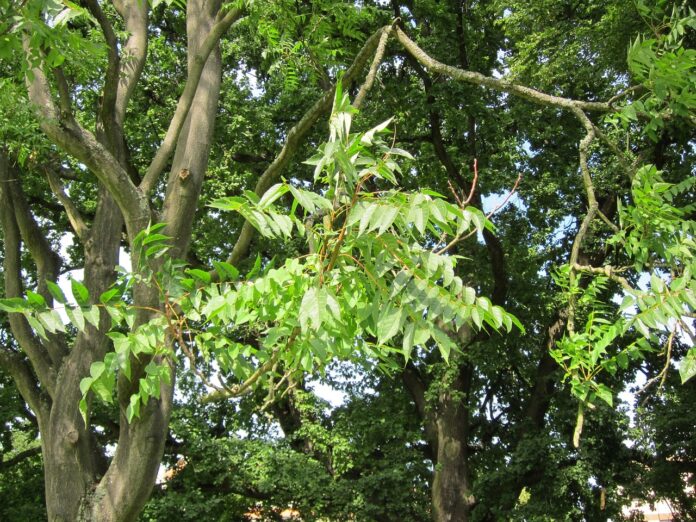When a landowner has a forestry management plan written, one of the common prescriptions to making a forest stand healthier is to control invasive species. Some common invasives that are found in forest stands include multiflora rose and nonnative honeysuckle.
Another common invasive that I often find along field edges or areas of disturbance is tree-of-heaven. The scientific name for tree-of-heaven is Ailanthus altissima. When talking to foresters or any other forestry professional they will use the name Ailanthus or tree-of-heaven.
According to Penn State Extension, tree-of-heaven was first introduced to the East coast in the 1700s. It was liked for its extremely rapid growth and ability to grow just about anywhere. Young sprouts can grow around 10 feet in a year if site conditions are good. This fast growth and ability to adapt to most site conditions has caused tree-of-heaven to become a major tree pest.
Tree-of-heaven is also known to secrete a chemical into the soil that is toxic to surrounding plants which can help reduce competition for resources and lead to low plant diversity in a forest stand.
Where to find it
While the tree-of-heaven does not grow well in shaded areas, it does take advantage of sunnier rights-of-way, trails, and other forest clearings. It will take over these areas very quickly by cloning itself using root sprouting. These sprouts can be sent out as far as 50 feet from the tree.
Colonies of tree-of-heaven will include both “male” and “female” trees. The females grow as many as 300,000 seeds each year. During the fall, the seeds will be red in color turning to a brown color during the winter. Female tree-of-heaven will often hold onto their seeds through much of the winter season.
How to identify it
The tree-of-heaven does resemble some native plants like sumac and black walnut. To identify the tree, look for smooth leaflet edges. The native trees will have serrated edges.
Tree-of-heaven will also produce a bad odor when leaves or twigs are crushed. Leaf scars on the tree-of-heaven are very large and twigs will have a brown spongy center. The bark of the tree will have vertical striping and be a smooth brownish green when the tree is young.
When the tree is older, the bark will resemble the outside of a cantaloupe in both color and texture. Older bark will still have that distinctive vertical striping.
Impact
In addition to tree-of-heaven negatively impacting native tree populations it also can produce negative impacts to human health. Landowners should take care when walking through or treating tree-of-heaven. The tree produces a chemical in the sap that can cause swelling of the heart muscle if introduced to the bloodstream through an open wound. The tree also produces a lot of pollen and is a source of allergy problems to some.
Unfortunately, I have found tree-of-heaven through many Ohio forest stands. It is especially easy to spot when driving down state routes.
If you find it
If a landowner does find this tree on their property, I urge you not to cut the tree down. Cutting the tree down will merely cause the tree to send warning signals to the roots, and lead to sprouting.
Please contact Ohio State University Extension for advice on chemical treatments. Penn State Extension also has great treatment advice on their website: https://extension.psu.edu/tree-of-heaven. If you think you may have tree-of-heaven on your property but are not sure, contact your ODNR Division of Forestry Service Forester or local SWCD office for assistance with identification.
Spotted lanternfly really like tree-of-heaven as a host plant so be mindful to check any of this particular tree species found for signs of the invasive insect.













thank you for a good article. Would it be possible to include more photos, like the flowers etc. It is difficult to identify with one , kind of long range, photo.
Thank you for your continued work and service
LD